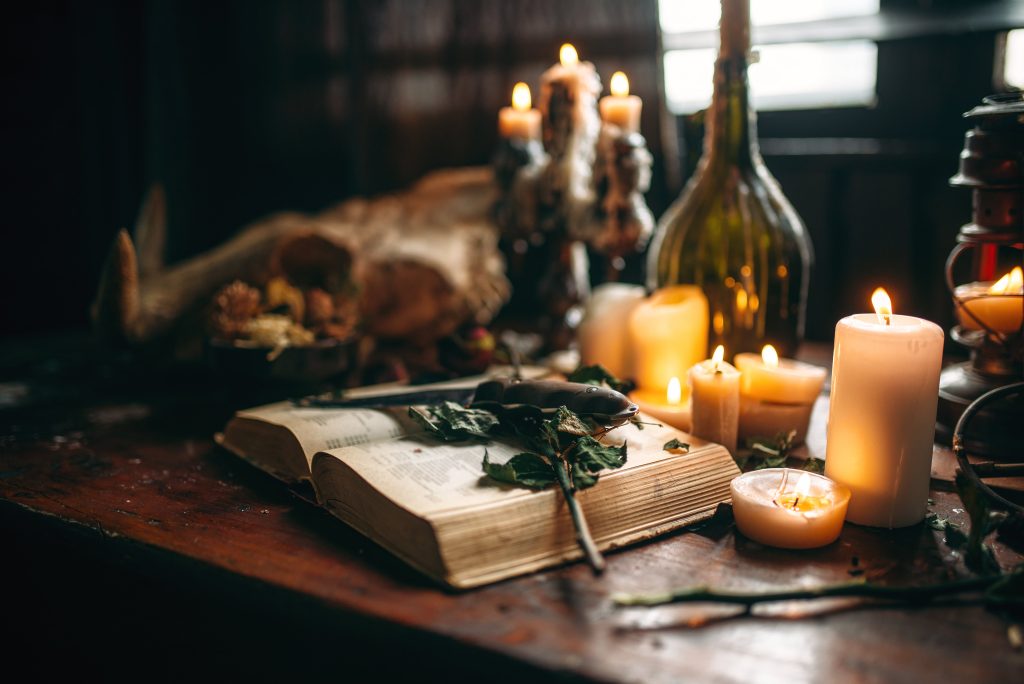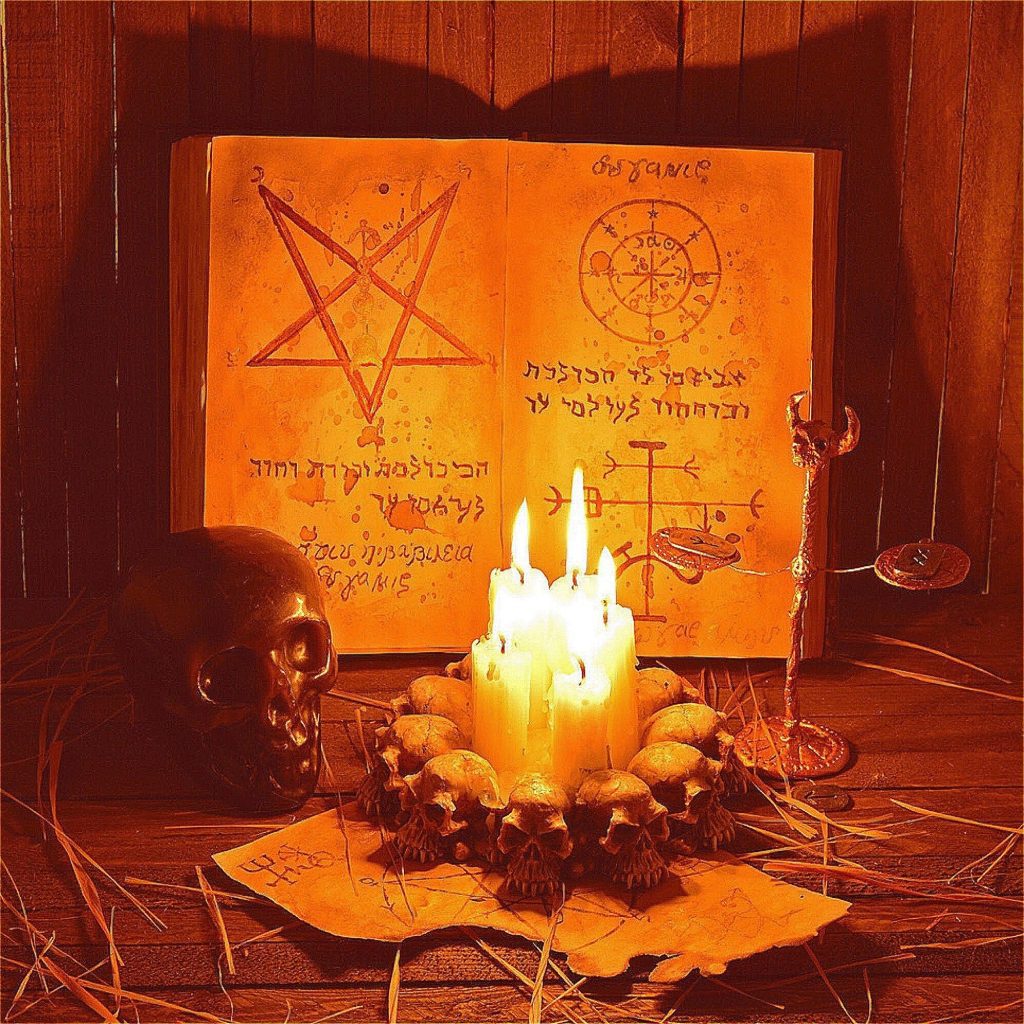In our quest for personal growth, spiritual connection, and self-discovery, the ritual book serves as a treasured companion on our journey. Whether ancient texts or modern compilations, these books hold the wisdom of rituals, offering guidance and inspiration for those seeking to create meaningful experiences. This article explores the significance of the ritual book, its role in spiritual exploration, and the transformative power it holds, including the use of witch symbols.
An Ancient Tradition
The tradition of the ritual book dates back to ancient civilizations, where the written word held great significance and knowledge was meticulously preserved. These books, often considered sacred, served as repositories of wisdom, offering guidance on rituals, ceremonies, and spiritual practices.
In ancient Mesopotamia, for example, clay tablets known as “incantation texts” contained rituals and spells aimed at invoking deities, healing diseases, or protecting against malevolent forces. These texts were used by priests and practitioners to perform ceremonies, conduct divination, and engage with the spiritual realm.
Egyptian civilization also had its collection of ritual texts, such as the “Book of the Dead.” These papyrus scrolls contained spells, prayers, and instructions to guide the deceased through the afterlife. The rituals and incantations inscribed in these books were believed to assist the departed in navigating the challenges and judgments they would encounter on their journey.
In ancient Greece, the concept of written rituals was prevalent as well. The Orphic Hymns, attributed to the mythical figure Orpheus, were poetic invocations to various gods and goddesses. These hymns were recited during religious ceremonies and were considered potent tools for connecting with the divine.
The tradition of ritual books extended to the Far East as well. In China, texts such as the “Book of Rites” (Li Ji) formed a comprehensive guide to rituals and ceremonies, encompassing various aspects of life, including governance, social etiquette, and religious practices. These texts provided a framework for harmonious living and the proper conduct of rituals in Confucian philosophy.
Similarly, in India, ancient scriptures like the Vedas, Upanishads, and Tantras contained rituals and mantras used in Hindu practices. These texts elucidated the intricate details of ceremonies, sacrifices, and meditation techniques, offering spiritual seekers a path to divine communion and self-realization.
The tradition of the ritual book was not limited to organized religions or ancient civilizations. Indigenous cultures across the globe had their own oral and written traditions, passing down sacred rituals and practices from generation to generation. Shamanic traditions, for instance, often involved ritualistic texts or songs that were chanted or recited during healing ceremonies, initiations, and spirit journeys.
Throughout history, the ritual book has served as a means of preserving and transmitting spiritual knowledge. These books were treasured by priests, initiates, and spiritual practitioners who dedicated themselves to the study and understanding of sacred rituals. They were considered sacred texts, embodying the collective wisdom and spiritual heritage of a culture or tradition.
In modern times, the tradition of the ritual book continues, with authors, scholars, and practitioners compiling and creating books that explore rituals, ceremonies, and spiritual practices from various traditions. These books provide a bridge between ancient wisdom and contemporary seekers, enabling individuals to delve into the profound and transformative power of rituals.
The ancient tradition of the ritual book reminds us of the enduring human quest for spiritual connection, guidance, and transcendence. It highlights the importance of written records in preserving and sharing sacred knowledge, allowing rituals and practices to transcend time and space, and providing a pathway for seekers to engage with the sacred in their own lives.


The Significance of The Ritual Book
Ritual books hold a profound significance that extends beyond their physical pages. They are revered for their ability to bridge the gap between the mundane and the sacred, and their importance is felt in various aspects of culture, religion, and society. Here, we delve deeper into the multifaceted significance of ritual books:
- Custodians of Tradition: Ritual books serve as custodians of cultural and religious traditions. They contain the accumulated wisdom of generations, preserving rituals, ceremonies, and practices that have been passed down through time. These books act as a reservoir of knowledge, ensuring that ancient customs remain intact and relevant to contemporary practitioners.
- Connection to the Divine: Rituals often provide a means to connect with the divine or the spiritual realm. Ritual books serve as guides for these interactions, offering the precise words, gestures, and actions required to establish this connection. By following the instructions in the ritual book, practitioners believe they can communicate with deities, ancestors, or spiritual forces.
- Continuity and Identity: Ritual books play a pivotal role in maintaining cultural and religious identity. They anchor individuals and communities in their heritage by enabling them to perform rituals that have been practiced for centuries. These rituals foster a sense of belonging and continuity, helping individuals understand their place within a broader historical and spiritual narrative.
- Transmitting Sacred Knowledge: Within the pages of ritual books lie sacred knowledge and teachings that are shared exclusively with those initiated into a particular tradition. This exclusivity adds to the reverence with which these books are treated, as they contain insights and practices reserved for those who have been entrusted with their stewardship.
- Structured Practice: Rituals often involve intricate sequences of actions, recitations, and offerings. Ritual books provide a structured framework for practitioners to follow, ensuring that each element of the ritual is carried out correctly. This structured practice lends a sense of order and discipline to the spiritual journey.
- Cultural Expression: Different cultures and religions have their unique ways of expressing their beliefs and values through rituals. Ritual books encapsulate these expressions, showcasing the art, music, poetry, and symbolism that are integral to the ritual experience. They serve as repositories of cultural creativity and artistic interpretation.
- Guardians of Mysteries: Some rituals are shrouded in secrecy and mysticism, known only to a select group of initiates. Ritual books, in such cases, become the guardians of these mysteries. They contain the esoteric knowledge that underpins these rituals, preserving their integrity while still allowing them to be transmitted across generations.
- Adaptation and Evolution: The ritual book also plays a role in adapting traditions to changing circumstances. While the core essence of rituals remains, the ritual book might be updated to accommodate shifts in societal norms, technological advancements, or shifts in understanding. This ensures that rituals stay relevant without compromising their authenticity.
download The Ritual Book
In essence, ritual books are not just instructional texts; they are repositories of spirituality, history, culture, and community. Their significance lies in their ability to encapsulate the essence of human experience and aspiration, providing a tangible link between the material and the transcendent. As long as rituals continue to hold meaning for individuals and societies, the ritual books that guide them will remain integral to the fabric of our shared human journey.
Contents and Structure of The Ritual Book
The ritual book, with its intricate instructions and symbolic significance, is a meticulously organized text that guides practitioners through the complexities of ceremonies and rituals. The contents and structure of this book can vary widely based on the specific tradition, culture, or religion it belongs to. However, there are several common elements that are often found within ritual books:
- Instructions and Procedures: At the heart of the ritual book are the step-by-step instructions for performing a particular ceremony or ritual. These instructions detail the precise sequence of actions, words, and gestures that need to be executed. The language used in these instructions is often formal and precise, leaving little room for ambiguity.
- Prayers, Chants, and Invocations: Rituals are often accompanied by prayers, chants, and invocations that hold deep spiritual significance. These texts are recited during different phases of the ritual to invoke blessings, protection, or communication with the divine. The wording and rhythm of these prayers contribute to the overall atmosphere of the ceremony.
- Symbolism and Meaning: Rituals are laden with symbolism, and the ritual book provides explanations for the meaning behind various actions, objects, and symbols used in the ceremonies. These explanations help practitioners understand the deeper layers of significance associated with each aspect of the ritual.
- Historical and Mythological Context: Many ritual books include historical narratives or mythological stories that provide context for the rituals being performed. These stories might explain the origins of the ritual, its significance within the tradition, and how it relates to the broader spiritual narrative.
- Roles and Responsibilities: In rituals led by specific individuals, such as priests, shamans, or officiants, the ritual book often outlines their roles and responsibilities. It details the tasks each person should perform, ensuring a coordinated and seamless execution of the ceremony.
- Sacred Texts and Passages: Some of the ritual books include excerpts from sacred texts that are pertinent to the ritual. These passages might come from scriptures, religious texts, or historical writings that hold special importance within the tradition.
- Offerings and Ritual Objects: Rituals often involve offerings, offerings, and the use of specific objects. The ritual book can include details about the types of offerings to be made, the significance of these offerings, and the proper handling of ritual objects.
- Variations and Adaptations: Depending on the tradition, region, or occasion, there might be variations in how a particular ritual is performed. Ritual books might provide alternative versions or adaptations to accommodate these differences while maintaining the core essence of the ritual.
- Notes and Annotations: Over time, ritual books might accumulate annotations, commentary, or insights from practitioners and scholars. These notes can provide additional context, explanations, or alternative interpretations of the rituals.
- Art and Visuals: Some of the ritual books are adorned with intricate illustrations, diagrams, and symbols that aid in understanding the rituals visually. These visuals can depict ritual setups, hand gestures, or diagrams of sacred spaces.
The structure of ritual books can vary from being linear and systematic to having a more cyclical arrangement based on the flow of the ritual itself. Additionally, as cultures and traditions evolve, some ritual books have been adapted into digital formats, incorporating multimedia elements like audio recordings and videos to enhance the learning and performance of rituals.
In essence, the contents and structure of ritual books aim to provide practitioners with a comprehensive and detailed guide to conducting rituals with precision, reverence, and authenticity. These texts are a bridge between tradition and practice, preserving the essence of cultural and spiritual heritage for future generations.


Preservation of Traditions Through The Ritual Book
In an ever-changing world where cultural and traditional practices are vulnerable to dilution or disappearance, the profound role of ritual books in safeguarding these invaluable heritages comes to the forefront. Ritual books serve as steadfast custodians of tradition, ensuring that the intricate tapestry of cultural and spiritual practices remains intact for the generations to come.
Ensuring Authenticity: The ritual book establisha reliable reference point for the execution of rituals, curbing the potential for misinterpretation that can arise through oral transmission. By adhering to the guidelines outlined within these texts, practitioners can ensure that rituals are conducted with genuine accuracy, thereby preserving the essence of their cultural and spiritual legacy.
Transmission of Knowledge: Functioning as repositories of wisdom, ritual books encapsulate the accumulated insights of bygone eras. These texts effectively bridge the temporal gap, allowing age-old rituals to be transferred to newcomers, initiates, and practitioners. The knowledge enshrined within these pages serves as a conduit between past and present, guaranteeing the perpetuation of traditions with unwavering fidelity.
Resisting Erosion: The vulnerability of cultural and religious practices to erosion caused by urbanization, globalization, and shifting societal norms is a real concern. The ritual book stands as resilient bulwarks against these influences by providing a written record that resists the eroding effects of time. It ensures that the core essence of rituals remains resolute even amidst the flux of change.
Mitigating Generational Gaps: In cases where generational divides hinder the understanding or practice of rituals, ritual books bridge these divides adeptly. Offering a structured resource, they empower younger generations to immerse themselves in their cultural and spiritual heritage. This facet guarantees the seamless transfer of traditions, even in situations where direct oral instruction might be challenging.
Cultural Continuity: The close interconnection between cultural traditions and rituals underscores the importance of ritual books. These texts facilitate the seamless continuation of these traditions, providing communities with an ongoing sense of unity and identity. The act of practicing rituals from the same cherished book as ancestors fosters a profound connection across temporal boundaries.
Adapting to Modernity: While firmly anchored in tradition,the ritual book can also gracefully evolve to accommodate the demands of contemporary circumstances. Adapting rituals for modern contexts can be seamlessly integrated into ritual books, ensuring the preservation of tradition while acknowledging the fluidity of changing times. This delicate equilibrium between preservation and adaptation secures the enduring relevance of these traditions.
Institutional Memory: Often held within religious institutions, cultural centers, or community spaces,the ritual book assumes the role of institutional memory. It serves as poignant reminders of a community’s historical roots, guiding them in upholding cherished values and practices that resonate through time.
Documentation of Evolution: The pages of the ritual book can eloquently document the evolution of a tradition across generations. Any changes, innovations, or modifications made to rituals find a place within these texts, forming a historical record of the tradition’s journey as it adapts while staying true to its foundational principles.
The profound significance of the ritual book in the realm of cultural and spiritual traditions becomes evident as it stands sentinel, safeguarding heritage practices. These texts serve as bridges spanning generations, repositories of precious knowledge, and portals to ancestral legacies. With their guidance, rituals that hold profound significance continue to flourish, allowing communities to celebrate their identities while nurturing a profound connection with their roots.
5 Best Recommended Ritual Books
There are several widely regarded ritual books that are considered authoritative sources in their respective traditions. Here are a few notable examples:
- “The Book of Common Prayer”:
This Anglican prayer book is a foundational text in the Anglican tradition. It contains liturgies, prayers, and rituals for various occasions, including worship services, sacraments, and rites of passage. “The Book of Common Prayer” has had a profound influence on Anglican and Episcopal worship and is recognized as a significant resource for Anglican rituals. - “The Key of Solomon”:
“The Key of Solomon” is a grimoire, or a book of magical rituals, dating back to the medieval period. It provides instructions for summoning spirits, creating talismans, and performing ceremonial magic. Although its origins and authorship are unclear, it is highly regarded in occult and magical traditions as a foundational text for ritualistic practices. - “The Golden Dawn”:
“The Golden Dawn” is a comprehensive system of ceremonial magic developed by the Hermetic Order of the Golden Dawn in the late 19th century. The order compiled a series of ritual books that outline their practices, including rituals, invocations, and meditation techniques. These books, such as “The Golden Dawn: A Complete Course in Practical Ceremonial Magic” by Israel Regardie, are esteemed resources for those interested in ceremonial magic and Western esoteric traditions. - “The Vedas”:
The Vedas are ancient Hindu scriptures that contain hymns, prayers, rituals, and philosophical teachings. They are considered the oldest and most authoritative texts in Hinduism. While there are multiple Vedic texts, the Rigveda, Samaveda, Yajurveda, and Atharvaveda are the principal ones. They provide guidance on rituals, sacrificial ceremonies, and spiritual practices within the Vedic tradition. - “The Book of Shadows”:
“The Book of Shadows” is a term used to refer to the personal ritual book of practitioners within Wicca and some Pagan traditions. It contains rituals, spells, invocations, and other magical information specific to the individual or coven. While there is no single authoritative “Book of Shadows,” many Wiccans and Pagans create and maintain their own personalized versions based on their beliefs and experiences.


Conclusion
The ritual book stands as a guidepost on the spiritual path, nurturing our connection with the sacred and facilitating transformative experiences. It holds the wisdom of ancient traditions and provides a framework for personal rituals and ceremonies. With its guidance, practitioners can embark on a journey of self-discovery, mindful awareness, and spiritual expansion. As we engage with the ritual book, we honor the rich tapestry of human spirituality and unlock the transformative power of rituals in our lives.


Pingback: The Ritual Book: A Guide to Sacred Practices an...
Pingback: Witch Symbols & Meanings | Explore Wiccan & Pagan Magic
Pingback: Witch Symbols & Meanings | Explore Wiccan & Pagan Magic